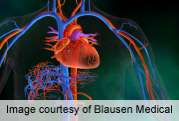Patients who experience acute chest pain, and have nonobstructive coronary artery disease, as determined by coronary computed tomographic angiography, have similarly benign outcomes as those with normal coronary arteries, according to a study published in the April 1 issue of The American Journal of Cardiology.
(HealthDay)—Patients who experience acute chest pain, and have nonobstructive coronary artery disease (CAD), as determined by coronary computed tomographic angiography, have similarly benign outcomes as those with normal coronary arteries, according to a study published in the April 1 issue of The American Journal of Cardiology.
Roy Beigel, M.D., from the Leviev Heart Institute in Israel, and colleagues analyzed 959 consecutive patients who underwent coronary computed tomographic angiography for assessment of acute chest pain. Patients were categorized as having normal coronary arteries (545 patients); nonobstructive CAD (any evidence of narrowing < 50 percent diameter stenosis; 312 patients); or obstructive CAD (narrowing of ≥ 50 percent diameter stenosis; 65 patients). Patients were followed for a minimum of 12 months (mean, 27 ± 11 months) for major adverse coronary events including death, nonfatal acute coronary syndrome, and coronary revascularization.
The researchers found that patients with nonobstructive CAD were older and had a greater prevalence of CAD risk factors, compared to patients with normal coronary arteries. For the normal and nonobstructive groups the incidence of major adverse coronary events was similarly low (0.6 percent and 1.3 percent, respectively; P = 0.2).
"In conclusion, patients with either nonobstructive CAD or normal findings, as evaluated by coronary computed tomographic angiography, for acute chest pain during an intermediate-term follow-up period had equally benign clinical outcomes," write the authors.
More information:
Abstract
Full Text (subscription or payment may be required)
Journal information: American Journal of Cardiology
Health News Copyright © 2013 HealthDay. All rights reserved.




















